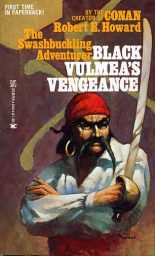Sensor Sweep: Emil Petaja, Battle of Hastings, Polish Legions, and Pirates
Monday , 5, February 2018 Sensor Sweep Leave a commentFiction (DMR Books): “ ‘Swords of the Red Brotherhood’ appears to take place before “Black Vulmea’s Vengeance.” It’s essentially the same story as the  Conan yarn “The Black Stranger”, recycled with a different protagonist. In both stories, a tainted noble with a relentless enemy has fled to a distant, savage coast and hidden there, until a three-cornered fight between three different pirate captains over a fabulous treasure brings the story to a bloody conclusion, after the usual shifting alliances and double-crosses. Vulmea cheerfully takes his own full part in the double-crosses, coming out the winner in the end, with a pirate ship and a pirate crew to follow him, about to return to the Spanish Main.”
Conan yarn “The Black Stranger”, recycled with a different protagonist. In both stories, a tainted noble with a relentless enemy has fled to a distant, savage coast and hidden there, until a three-cornered fight between three different pirate captains over a fabulous treasure brings the story to a bloody conclusion, after the usual shifting alliances and double-crosses. Vulmea cheerfully takes his own full part in the double-crosses, coming out the winner in the end, with a pirate ship and a pirate crew to follow him, about to return to the Spanish Main.”
Fiction (On an Underwood No 5): “Emil Petaja first appears on the scene in a letter to Weird Tales (June 1932). The sixteen year old reader of science

Emil Petaja
fiction and fantasy soon fell into the gravitational pull of fandom, becoming a subscriber to The Fantasy Fan; his first letter appeared in the Dec 1933 issue, on the opposite page from letters by Robert E. Howard and H. P. Lovecraft; he was soon an active contributor with the article series “Famous Fantasy Fiction” (Feb, Jul, Aug 1934), which consisted of brief descriptions of volumes of weird and fantastic fiction.”
Board Games (Worthington Publishing): “The Battle of Hastings was one of the decisive battles in the history of Europe. As a result of this Norman  victory, for three centuries England suffered French-speaking kings and nobles, and the individual people (the Saxons) lost much of their freedom.
victory, for three centuries England suffered French-speaking kings and nobles, and the individual people (the Saxons) lost much of their freedom.
Hastings 1066 is a short game for two players using a simple “board” and cards representing the units. One player is the Saxons (English) led by Harold Godwinson (King Harold II); the other is the Normans, led by William of Normandy, later known as William the Conqueror because he was lucky enough to survive and win the battle.”
Writers (Jeffro Johnson): “Hell hath no fury like a woman scorned. And so it is that the women you’d least like to see in the centerfold of a girlie magazine often turn out to have the greatest amount of bile and resentment. That’s perhaps the most ironic thing about Ursula Le Guin’s ‘Nine Lives’, which really was published in Playboy magazine: the contrast it provides when set against the inherent appeal of the young, the voluptuous, and the fertile.”
Games (Boardgamegeek): “What’s a surefire recipe for success on Kickstarter? Take an out-of-print game that’s commanding huge after-market prices like Endeavor from Carl de Visser and Jarratt Gray, update it with a double-sided game board and new components to add more variety to the game, then release with it artwork that might be even more compelling than the original look. For an example of just such a project, turn to Endeavor: Age of Sail, a joint production from Burnt Island Games and Grand Gamers Guild. (KS link)”
War Gaming (Osprey): “Due to its partitions and dissolution in the late eighteenth century, hundreds of thousands of Polish soldiers enlisted in distinct  units in the armies of many countries – primarily those of the Russian and Austro-Hungarian empires, but also that of the German Reich and the French Republic.
units in the armies of many countries – primarily those of the Russian and Austro-Hungarian empires, but also that of the German Reich and the French Republic.
All these forces were uniformed and equipped by the parent armies, though often with explicitly Polish features. The collapse of Tsarist Russia in 1917 and of the Central Powers in 1918 allowed these diverse forces to unite in a re-created Polish Army under the new-born Second Polish Republic in November 1918. With full colour illustrations of their unique and colourful uniforms as well as contemporary photographs, this is the fascinating story of the Poles who fought on both sides of the trenches in World War I and then united to fight for their freedom in the Russian Civil War.”
Please give us your valuable comment